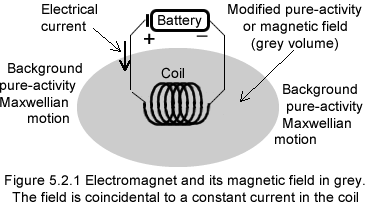
Magnetic field (§5.2)
Magnetic fields occur around magnets and also around electromagnets.While magnets and electromagnets strongly interact among themselves, charged particles such as electrons stay put or maintain their continuous motion within the magnetic fields that surrounds magnets and electromagnets.
An electromagnet, which behave just as magnets do, is made of a coil of wire in which a constant current is flowing.
The modified pure-activity represented as a grey volume surrounding the coil in the figure is implemented physically in great details in the next section (§5.3).
A magnet is made of a ferromagnetic metal such as iron that has been magnetized.
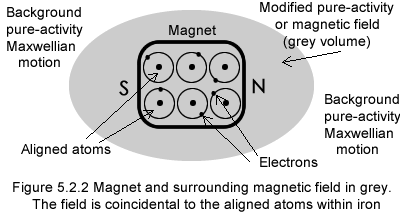 When the metal is magnetized its atoms are aligned in such ways that the planes in which are circling the electrons are parallel to each other. Each electron looks like an electrical current, and being all aligned their individual effects add up and create the magnetic field. Should the magnet be heated its atoms would be forced into a strong agitated Maxwellian motion and the magnetic effect would disappear. That is an experiment easily performed proving first that the atoms are aligned at low temperature then that the atoms regain their moving liberty at higher temperature.
When the metal is magnetized its atoms are aligned in such ways that the planes in which are circling the electrons are parallel to each other. Each electron looks like an electrical current, and being all aligned their individual effects add up and create the magnetic field. Should the magnet be heated its atoms would be forced into a strong agitated Maxwellian motion and the magnetic effect would disappear. That is an experiment easily performed proving first that the atoms are aligned at low temperature then that the atoms regain their moving liberty at higher temperature.A magnetic field, whether engendered by a magnet or an electromagnet, unlike an electric field, has no effect on electrons and protons particles. Magnetic fields on the other hand attract and repel other magnetic fields, as one can experiment with 2 magnets.
The right hand rule
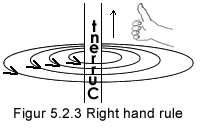 In physics a magnetic field is represented with oriented field lines as in figure 5.2.3. Physics doesn’t specify what these lines are made of, but provides them an orientation. The field lines follow the right hand rule. Orienting your right thumb in the direction of the current and folding the other 4 fingers, the magnetic field lines curl in the direction of these 4 fingers.
In physics a magnetic field is represented with oriented field lines as in figure 5.2.3. Physics doesn’t specify what these lines are made of, but provides them an orientation. The field lines follow the right hand rule. Orienting your right thumb in the direction of the current and folding the other 4 fingers, the magnetic field lines curl in the direction of these 4 fingers.The electrical current in the electrical wire is either a current of protons in the direction of the thumb or a current of electrons flowing in the opposite direction.
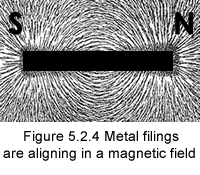 Physics field lines can be physically outlined with metal filings; the latter align themselves along lines as shown in figure 5.2.4.
Physics field lines can be physically outlined with metal filings; the latter align themselves along lines as shown in figure 5.2.4.Yet it must be noted that the filings do not show physically any direction. How does one decide in physics which end of a magnet is north, using the right hand rule? While it distinguishes one pole from the other in an electromagnet, it doesn’t help in case of the magnet; the right hand rule could have been left hand rule it would have worked as well! Magnets and electromagnets would still attract and repel as they do!
The point is that the right hand rule provides no clue on the physical link that exists between the direction of the current, either in the wire (Fig 5.2.1) or in the atoms (Fig 5.2.2), and the physical entities (grey area of these 2 figures) that surround in space the 2 opposite ends of a magnet! Physics doesn’t even mention what differentiates in space a positive from a negative pole!
FYI it has been a challenge for me to discover the motion-activity that occurs in pure-activity (space) surrounding a magnet and that at same time fits all of the physical experiments; I went through several months of thinking trial and error, along which I thought more than once I had a solution to find out that was not matching all of the physical contingencies of Nature.
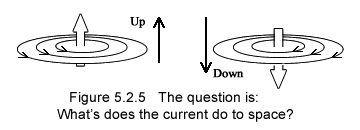 I finally came up with the idea of drawing figure 5.2.5, in which the Up and Down arrows, are drawn in space in line with the current.
I finally came up with the idea of drawing figure 5.2.5, in which the Up and Down arrows, are drawn in space in line with the current.And that put me on the track of finding a solution, which is as amazing as it is simple and that you might appreciate!
All in all, there is something in space linked to the direction of the current in the wire; and while that something is having no action on a still electrical charge, it nevertheless interacts on another yet similar something entity in space, such that these 2 something’s create the strong interactions that occur between 2 magnets!